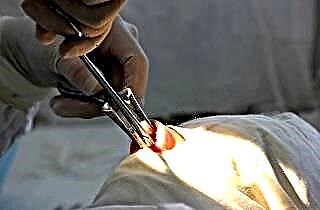Causes and factors for the development of pathology
The most common cause of the disease is atherosclerosis. It is a long-term current pathological process, during which the vessel wall becomes rigid and cholesterol plaques are deposited in it, which are sources of local inflammation.
These formations narrow the lumen of the vessel, blocking the access of oxygenated blood to the tissues. They are the culprits of thrombosis, which poses a threat not only to the affected limb, but also to all organs of the body.
Other causes of atherosclerosis obliterans:
- Diabetes. High blood sugar damages the arterial wall, promoting blood clots. In such patients, lipid metabolism is often impaired and blood pressure is increased.
- Vascular inflammation. This condition is called arteritis, or vasculitis. The reason is the body's autoimmune reactions.
- Infectionssuch as salmonellosis and syphilis.
- Structural defects (vascular pathologies that have arisen at the stage of intrauterine development).
Risk factors that increase the likelihood of getting sick:
- several deaths from myocardial infarction or stroke in the family;
- age over 50;
- excess weight;
- inactive lifestyle;
- smoking;
- diabetes;
- arterial hypertension;
- lipid metabolism disorders;
Classification and course of the disease
Atherosclerotic plaque consists of cholesterol deposits and is covered with a fibrous layer of tissue. The core gradually grows, filling with contents and blocking the lumen of the middle and large arteries, up to complete occlusion. If fat breaks into the bloodstream, platelets and fibrin are quickly deposited on the plaque bed. This is how a blood clot forms.
Emboli have a different origin, being particles of a tumor or warty masses on the heart valves affected by the infection. Sometimes they form if there are obstacles to the physiological blood flow: aortic aneurysm, congenital and acquired heart defects.
When thrombosis, embolism, or trauma occurs, the disease begins to manifest acutely. The site of circulatory arrest and the presence of additional vessels (collaterals) determine the severity of symptoms and the development of complications.
There are 4 stages of the course of the disease:
- I. Pain sensations increase with heavy exertion and during long walking (more than 1000 meters).
- Stage II:
- A: pain begins when walking from 250 to 1000 m;
- V: when walking from 50 to 250 m.
- Stage of critical ischemia. Pain syndrome occurs with complete calmness and during sleep.
- Stage of dystrophic disorders. Necrosis is found on the heels and toes, which tend to develop into gangrene.
Symptoms and Signs
Only about half of the patients have complaints. Most of the symptoms are associated with restricted circulation to the leg muscles.
The most common manifestation is discomfort in one or both calves as well as thighs... Unpleasant sensations arise when walking, climbing stairs, running and stop after a short rest. This pain is called intermittent... It can be dull and stabbing, accompanied by heaviness, fatigue in the legs during the day. Sometimes tingling and spasms bother the patient at night.
Other symptoms include:
- numbness, tingling, weakness in the legs;
- pain in the gluteal muscles;
- burning sensation in feet or toes;
- ulcers on the feet that do not heal;
- Dry gangrene;
- discoloration of the limb: cyanosis, redness, pallor;
- loss of hair on the legs;
- impotence.
Photo of the lower extremities of a patient with atherosclerosis obliterans:
Diagnostics
The basic examination includes the following activities:
- The classic symptom that underlies the disease definition protocol is pain when walking.
- Examination and palpation at later stages help to identify the consequences of the disease - foci of necrosis and impaired sensitivity.
- Special questionnaires are used that are filled out by the patient. They help to structure complaints and clinical manifestations for later analysis.
- Measurement of the ankle-brachial index. For this, the blood pressure in the upper and lower extremities is correlated.
Instrumental research:
- Stress test measures the pressure in the limbs before and after the treadmill. If pain occurs during the examination, you can establish a specific stage of the disease.
- Doppler ultrasound allows you to determine the patency and level of blockage of the vessel, as well as to study the possibilities of collateral circulation.
- MRI makes it possible to visualize the site of narrowing of the artery in detail and determine the scope of surgery, especially if stenting is planned.
- Angiography (filling the vessel with contrast and determining it under X-ray radiation) is a diagnostic and at the same time therapeutic method, since, having identified a narrowing of an artery, it is possible to immediately carry out balloon dilatation.
Treatment, rehabilitation and labor expertise of the patient
Conservative treatment of obliterating atherosclerosis of the lower extremities provides for blood pressure control, correction of blood lipids, optimization of sugar content in diabetic patients and taking blood thinners.
Medicines recommended by doctors:
- Thrombolytics dissolve an already formed clot ("Heparin"). These drugs are prescribed only in a clinic under the supervision of a physician, as they can easily cause bleeding if used incorrectly. For effective action, medications must be administered intravenously in the first 4-8 hours after the development of acute symptoms of vascular obstruction. This is the main reason not to delay the visit to the doctor.
- Antiplatelet agents and anticoagulants prevent the occurrence of emboli and blood clots. An additional useful property of these drugs is the expansion of the lumen of the arteries, which facilitates blood flow (Warfarin, Xarelto, Dabigatran, Aspirin, Clopidogrel).
- Drugs that improve blood circulation in the peripheral vessels (antispasmodics) are not included in the standard of treatment, but they have a small positive effect on the severity of symptoms.
Additional funds
- Analgesics are used to relieve pain. They reduce stress and calm the patient, but do not take them on their own for a long period, as they change the clinical picture and make diagnosis more difficult.
- Antihypertensive drugs (beta-blockers, ACE inhibitors, diuretics) control blood pressure, which is usually elevated in these patients.
- Insulin and glucose-lowering drugs are essential for people with diabetes. If such patients experience discomfort in the calves and feet, the dosage of the medication must be adjusted immediately.
In cases where the blockage of the vessel is critical and drug treatment does not allow to restore blood circulation in the limb, the patient is advised to surgically treat obliterating atherosclerosis. His methods are:
- Percutaneous (percutaneous) balloon angioplasty.
The method involves the introduction of a special catheter into the affected artery. Under X-ray control, thanks to the contrast agent, it is possible to pinpoint the site of thrombosis or constriction and expand it with a balloon located at the end of the tube.
After the doctor performing the procedure is satisfied that blood flow has been restored, the device is removed. The operation is performed under local anesthesia (medication sleep is possible at the request of the patient).
The advantages of this technique are the possibility of performing it during diagnostics, as well as the relative low cost. The disadvantage of this method is the high risk of recurrence of the disease.
- Stenting.
The procedure involves placing a metal frame inside the artery. The device is inserted under the control of an X-ray machine using a catheter. However, this method is also imperfect: over time, the stent becomes overgrown with tissue, and therefore a second operation may be required. The cost of the intervention is quite high (over $ 1000), which depends on the type and properties of the stent itself.
- Atterectomy.
The manipulation consists in removing plaque and calcifications using a special device that "cuts" them. The procedure is performed by intravascular access. After resection of atheroma, a stent is placed. This technology prevents restenosis.
- Bypass surgery.
Shunt placement is a reconstructive intervention based on vessel implantation and artificial creation of a collateral bypassing the blood flow obstruction. For this purpose, synthetic materials or vein grafts from healthy areas of the legs are used.
Unfortunately, sometimes doctors have to go to extreme measures and amputate limbs at different levels. Such an operation is necessary if necrosis and gangrene develop, in cases where the disease is detected too late or progresses very quickly with concomitant pathology, and the previous treatment did not work.
Atherosclerosis obliterans is a serious disease that limits the activity of patients. After the treatment, the patient should undergo a medical and social examination (MSE) to determine the terms of incapacity for work, the appointment of rehabilitation or the establishment of a disability group, if necessary.
Due to the severity of the disease and the characteristics of treatment, it is important to carry out timely prevention, which includes the following:
- smoking cessation;
- little daily activity: even skipping a couple of transport stops for walking or walking the dog has a positive effect on the physical and emotional state;
- correction of the composition of the daily diet (limiting the content of salt and animal fats);
- maintaining optimal weight;
- regular monitoring of blood pressure.
Obliterating atherosclerosis of the vessels of the lower extremities does not always respond to therapy successfully and often leads to disability. The origin of the disease is closely related to arterial hypertension, lipid metabolism disorders and diabetes mellitus. It is the impact on these negative factors with the correct lifestyle and adequate treatment that significantly improves the patient's prognosis.



